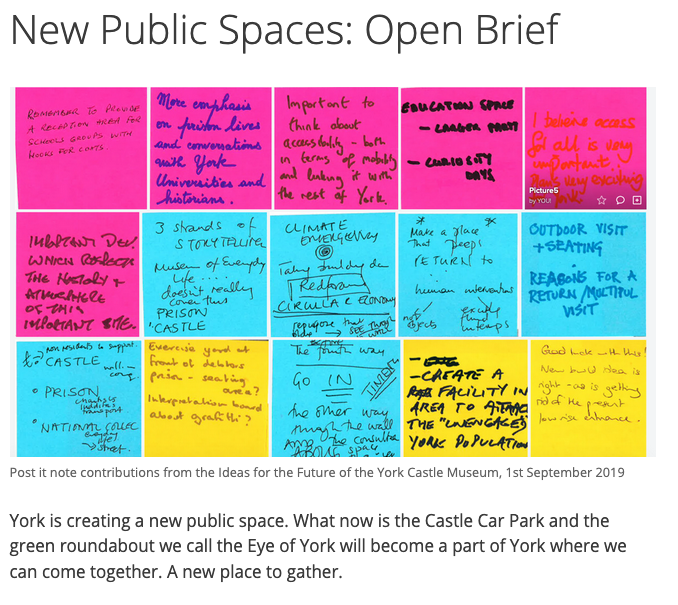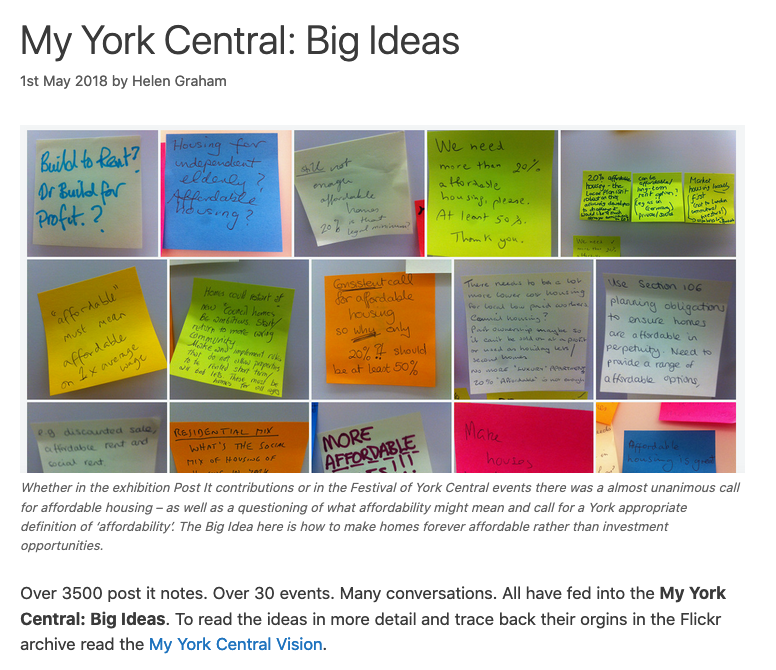Updated May 2021
The My Future York approach has been developed through My Castle Gateway and My York Central. Below we identify key aspects of the approach and give specific examples from the two projects. While we have separated out different steps in the process, all the steps are underpinned by an ethos (in the sense of an attitude and spirit) taken towards the work: that is believing that being actively involved in your city is both a right and an enormously rewarding act of collective creativity. At the heart of the process is inviting and valuing investment of time, creativity and energy from the community. This process does need to be matched by investment of time and resources by the council, and this needs to be planned for.
Ways of Working
In summary, our approach is:
- Build a brief: Start with the personal… and make different people’s needs and ideas visible
- Explore Challenges: Cultivate a grown up and sophisticated public debate about complex issues
- Make change together: Facilitate community networks and local action as well as long term community influence in decision-making, design and delivery.

In more depth:
Start with the ‘my’: Use personal narrative and by asking people specifically about what they would like to do in the future. This both avoids ideas being generated ‘on behalf of’ others and makes the fact that different people have different needs and ideas visible.
In practice: We started using this approach when we started My Future York with asking people to do two ‘Day In My Life’ stories, one for this year and one for ten years in the future. We developed this approach into the design of public events through working with Coaching York, who developed walks around Castle Gateway which used open questions to go on walks to imagine different futures.
Open up the issues and design ways of working: Start by calling for questions from lots of different perspectives and identify the fundamental concerns and challenges. Use these as a starting point to design a process which enables ideas to be articulated through a range of events which draw useful information and ideas into the debate. It is crucial to start this process early enough for the public conversations to be able to genuinely set the agenda.
In practice: In preparing for the festival of York Central we did an open call for questions via social media (#MYCQuestions) and a number of event with elected members. We used these questions to design the events – and meet partners to co-produce events – as part of the Festival of York Central.
Identify and engage constituencies: Every place or issue creates its own communities of proximity or interest. Find out who cares, both by working actively with those that come forward and by pro-actively reaching out to those that don’t. Keep discussions and events open to all to ensure groups and individuals aren’t excluded and don’t feel the need to open up competing conversations.
In practice: We know not everyone who cares about a place or issue will come along to public events. In Castle Gateway we also actively approached groups who we thought might have a lot to say such as Peasholme Centre, York Blind and Partially-Sighted Society and the Youth Council to develop specific discussion. Building relationships this way has led to individuals who are linked to those groups coming along to the public events.
In York Central, we work with ward members to door knock to reach the widest range of local people, as well as attend coffee mornings in the Leeman Road and Poppleton Road area and work with local schools. We also developed topic-relevant drop in family workshops to engage families who were in the NRM anyway during the Easter Holidays.
We also worked hard to engage with members of York Central Action, which had been established in response to the invite-only Community Forum, which had been set up prior to us being commissioned.
Build a ‘public sphere’ through collaborative inquiry: Cultivate a grown up and sophisticated public debate about complex issues through a shared sense of exploration. Embrace the people who are sometimes dismissed as the ‘usual suspects’ of community activism and enable individuals with particular knowledge, viewpoint or experience to lead, contribute and provide resources for collective exploration, by co-producing events and media. Write up these events so they all contribute to the overall inquiry.
In practice: Throughout the Festival of York Central we ran events that sought to address complex issues, bringing in people with knowledge and ideas and then creating scope for high quality conversation. We’ve developed an approach to documenting events so that we can quickly write up and blogs events, so we can create a sense of an open inquiry into the issues and those not present can still read about the discussions.
Through working with the council’s Castle Gateway team, an approach to social media was developed that created short and engaging films about key issues, this used the council’s own social media channels to reach a wider range of people. Together we also explored how we might develop a higher quality conversation through social media, asking open and positive follow up questions and asking people to share specific examples of things they’d like to be able to do in Castle Gateway.
Cross boundaries and seek connections: Seek and clarify connections between issues and ideas in order to build more rich and integrated proposals, notice where there are blocks and sticking points and explore how they can be addressed… and very literally connect up people who could help move on the debate if they had a direct conversation.
In practice: In My Castle Gateway we tended to work with groups separately. So we ran events with York Blind and Partially Sighted Society, the Youth Council or with cyclists and cycle couriers. Each of these events generated valuable insights and informed the brief we developed for the masterplanners.
In the Festival of York Central we developed this approach further and sought to bring people with different perspectives together. One persistent issue of disagreement is over ‘shared space’ between pedestrians and cyclists, it is especially unpopular with York Blind and Partially Sighted Society. Over a series of events, including one with a focus on Castle Gateway and movement, we create dialogues about ‘shared space’ from people with different perspectives and have generated a more nuanced picture, focused on differentiating based on purpose of trip (commuting/leisure) and clarity over the direction of cycle traffic, rather than simply differentiation based on mode of transport.
Build community briefs for formal decision-making: Analyse and structure information to produce purposeful documents – briefing documents, vision documents, reports on feedback – which can feed into formal decision-making.
In practice: We have sought to make transparent the workings of how contributions turn into briefs, visons or principles clear through creating an online archive of all contributions (using Flickr), tagging all contributions and using hyperlinks to locate different aspects of the documents we produce.
In My Castle Gateway, the first phase of work was pulled together into a community-led statement of significance and an Open Brief that informed the masterplan. We later produced an New Public Spaces Open Brief, which informed a design process in spring and summer 2021.
As we noted above, our first step with the Festival of York Central was to ask people for questions they might have about York Central. We used these questions to identify themes from the Festival of York Central events: Public Space, Homes, Work and Movement. Each week – on a Sunday – we ran an open workshop to collaboratively make sense and draw out an open brief. At the end of Festival, we then sought to identify the connections between the areas in a series of documents: My York Central Big Ideas, Vision and Principles.

Make change together: Use the process above to ultimately build partnerships between community groups, informal networks, individuals and public agencies to enable change to be made in a collective and inclusive way.
In practice: When we asked people what they wanted to do in Castle Gateway area a number of individuals said ‘swim in the rivers’, to the same question York Rescue Boat answered ‘stop people drowning in the rivers’. Through the Living Well With Water network York’s wild swimmer and York Rescue Boat are now collaborating to how to swim safely and how to ‘make York’s rivers friendly again’.
Drawing on a very clear desire from many to continue very active involvement in what York Central becomes, we have worked with a network of people to develop York Central Co-Owned to bring the My York Central Big Ideas to life on York Central.
Ethos
These steps work as they are carried out in a certain spirit. Below we tease out the ethos that makes the ways of working above possible.
Key idea: Underpinning these ways of working is an approach to local democracy as a participatory process where we seek to understand the issues, come up with creative solutions and make change together.
Local democracy is collaborative inquiry…
- Start with not yet knowing what should happen but believe that positive change is possible.
- Refuse to limit ideas and possibilities (‘we tried that before’, ‘that’s impossible’) before they have been fully explored.
- Believe that all issues, no matter how complex, can and should be opened up for public discussion, and that often the most “problematic” issues bring the richest debate and most significant outcomes.
- Develop an approach to complex issues that recognises that they can only be understood and worked with by seeing them from lots and lots of different perspectives…and so to understand complex issues requires lots of different people to be involved.
Local democracy is creativity…
- Develop ways of participating that make taking part in the process of forming and developing a brief a creative and fulfilling experience that brings people together.
- See engagement in this process as a default part of citizenship-by-choice – anyone who wants to play a part in shaping the future of the city should be able to do so.
Local democracy is making change together…
- Enact local democracy as a collaboration between the council, local people and other commercial and third-sector players based on trust, openness and willingness on all sides.
We’re currently explore whether deliberative systems and systems thinking can help with conceptualising creative public engagement and local democracy.